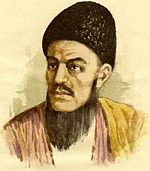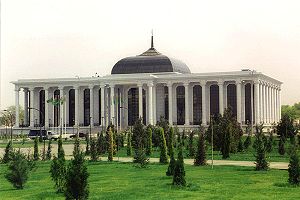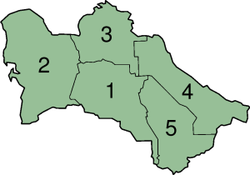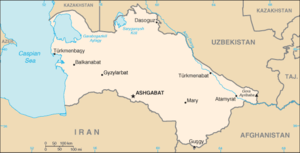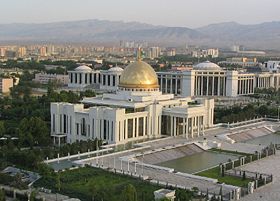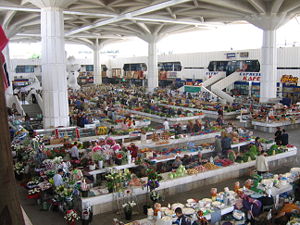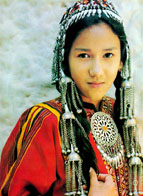Turkmenistan
2008/9 Schools Wikipedia Selection. Related subjects: Asia; Asian Countries
| Türkmenistan Turkmenistan
|
||||||
|---|---|---|---|---|---|---|
|
||||||
| Anthem: Independent, Neutral, Turkmenistan State Anthem |
||||||
|
|
||||||
| Capital (and largest city) |
Ashgabat |
|||||
| Official languages | Turkmen | |||||
| Recognised regional languages | Russian, Uzbek, Dari | |||||
| Demonym | Turkmen | |||||
| Government | Single-party state | |||||
| - | President | Gurbanguly Berdimuhammedow | ||||
| Independence | from the Soviet Union | |||||
| - | Declared | October 27, 1991 | ||||
| - | Recognized | December 8, 1991 | ||||
| Area | ||||||
| - | Total | 488,100 km² ( 52nd) 188,456 sq mi |
||||
| - | Water (%) | 4.9 | ||||
| Population | ||||||
| - | December 2006 estimate | 5,110,023 ( 113th) | ||||
| - | Density | 9.9/km² ( 208th) 25.6/sq mi |
||||
| GDP ( PPP) | 2006 estimate | |||||
| - | Total | $45.11 billion ( 86th) | ||||
| - | Per capita | $8,900 ( 95th) | ||||
| HDI (2007) | ▼ 0.712 (medium) ( 109th) | |||||
| Currency | Turkmen Manat ( TMM) |
|||||
| Time zone | TMT ( UTC+5) | |||||
| - | Summer ( DST) | not observed ( UTC+5) | ||||
| Internet TLD | .tm | |||||
| Calling code | +993 | |||||
Turkmenistan ( Turkmen: Türkmenistan; also known as Turkmenia) is a Turkic country in Central Asia. The name Turkmenistan is derived from Persian, meaning "land of the Turkmen". The name of its capital, Ashgabat, derived from Persian as well, loosely translating as "the city of love". Until 1991, it was a constituent republic of the Soviet Union, the Turkmen Soviet Socialist Republic. It is bordered by Afghanistan to the southeast, Iran to the southwest, Uzbekistan to the northeast, Kazakhstan to the northwest, and the Caspian Sea to the west.
According to CIA World Factbook 2006 figures, Turkmenistan ranks 5th in the world for GDP growth rate. Although it is wealthy in natural resources in certain areas, most of the country is covered by the Karakum (Black Sands) Desert. It has a single-party system, and was ruled by President for Life Saparmurat Niyazov until 21 December 2006, when he (and his term) expired. Presidential elections were held on 11 February 2007. Gurbanguly Berdimuhammedow was declared the winner with 89% of the vote. He was sworn in on 14 February 2007.
History
The territory of Turkmenistan has a long and checkered history, as armies from one empire after another decamped there on their way to more prosperous territories. The region's written history begins with its conquest by the Achaemenid Empire of ancient Persia, as the region was divided between the satrapies of Margiana, Khwarezm, and Parthia.
Alexander the Great conquered the territory in the fourth century BCE on his way to South Asia, around the time that the Silk Road was established as a major trading route between Asia and the Mediterranean Region. One hundred and fifty years later, Persia's Parthian Kingdom established its capital in Nisa, now in the suburbs of the capital, Ashgabat. In the seventh century CE, Arabs conquered this region, bringing with them Islam and incorporating the Turkmen into Middle Eastern culture. The Turkmenistan region soon came to be known as the capital of Greater Khorasan, when the caliph Al-Ma'mun moved his capital to Merv.
In the middle of the eleventh century, the Turkoman-ruled Seljuk Empire concentrated its strength in the territory of modern Turkmenistan in an attempt to expand into Khorasan (modern Afghanistan). The empire broke down in the second half of the twelfth century, and the Turkmen lost their independence when Genghis Khan took control of the eastern Caspian Sea region on his march west. For the next seven centuries, the Turkmen people lived under various empires and fought constant intertribal wars. Little is documented of Turkmen history prior to Russian engagement. However, from the thirteenth to the sixteenth centuries, Turkmen formed a distinct ethnolinguistic group. As the Turkmen migrated from the area around the Mangyshlak Peninsula in contemporary Kazakhstan toward the Iranian border region and the Amu Darya basin, tribal Turkmen society further developed cultural traditions that would become the foundation of Turkmen national consciousness.
Between the seventeenth and nineteenth centuries, control of Turkmenistan was fought over by Persian shahs, Khiva khans, the emirs of Bukhara and the rulers of Afghanistan. During this period, Turkmen spiritual leader Magtymguly Pyragy reached prominence with his efforts to secure independence and autonomy for his people. At this time, the vast territory of Central Asia including the region of Turkmenistan was largely unmapped and virtually unknown to Europe and the Western world. Rivalry for control of the area between the British Empire and Tsarist Russia was characterised as The Great Game. Throughout their conquest of Central Asia, the Russians were met with the stiffest resistance by the Turkmen. By 1894, however, Russia had gained control of Turkmenistan and incorporated it into its empire. The rivalry officially concluded with the Anglo-Russian Convention of 1907. Slowly, Russian and European cultures were introduced to the area. This was evident in the architecture of the newly-formed city of Ashgabat, which became the capital. The October Revolution of 1917 in Russia and subsequent political unrest led to the declaration of the area as the Turkmen SSR, one of the six republics of the Soviet Union in 1924, assuming the borders of modern Turkmenistan.
The new Turkmen SSR went through a process of further Europeanization. The tribal Turkmen people were encouraged to become secular and adopt European-style clothing. The Turkmen alphabet was changed from the traditional Arabic script to Latin and finally to Cyrillic. However, bringing the Turkmens to abandon their previous nomadic ways in favour of communism was not fully embraced until as late as 1948. Nationalist organizations in the region also existed during the 1920s and the 1930s.
When the Soviet Union began to collapse, Turkmenistan and the rest of the Central Asian states heavily favored maintaining a reformed version of the state, mainly because they needed the economic power and common markets of the Soviet Union to prosper. Turkmenistan declared independence on October 27, 1991, one of the last republics to secede.
In 1991, Turkmenistan became a member of the Commonwealth of Independent States, an international organization of former Soviet republics. However, Turkmenistan reduced its status in the organization to "associate member" in August 2005. The reason stated by the Turkmen president was the country's policy of permanent neutrality. It is the only former Soviet state (aside from the Baltic states now in the European Union) without a full membership.
The former Soviet leader, Saparmurat Niyazov, remained in power as Turkmenistan's leader after the dissolution of the Soviet Union. Under his post-Soviet rule, Russian-Turkmeni relations greatly suffered. He styled himself as a promoter of traditional Muslim and Turkmen culture (calling himself "Turkmenbashi", or "leader of the Turkmen people"), but he became notorious in the West for his dictatorial rule and extravagant cult of personality. The extent of his power greatly increased during the early 1990s, and in 1999 he became President for Life.
Niyazov died unexpectedly on December 21, 2006, leaving no heir apparent and an unclear line of succession. A former deputy prime minister rumored to be the illegitimate son of Niyazov, Gurbanguly Berdimuhammedow, became acting president, although under the constitution the Chairman of the People's Council, Ovezgeldy Atayev, should have succeeded to the post. However, Atayev was accused of crimes and removed from office.
In an election on February 11, 2007, Berdimuhammedow was elected president with 89% of the vote and 95% turnout, although the election was condemned by outside observers as unfair.
Politics
The politics of Turkmenistan take place in the framework of a presidential republic, with the President both head of state and head of government. Turkmenistan has a single-party system.
After 69 years as part of the Soviet Union (including 67 years as a union republic), Turkmenistan declared its independence on October 27, 1991.
President for Life Saparmurat Niyazov, a former bureaucrat of the Communist Party of the Soviet Union, ruled Turkmenistan from 1985, when he became head of the Communist Party of the Turkmen SSR, until his death in 2006. He retained absolute control over the country after the dissolution of the Soviet Union. On December 28, 1999, Niyazov was declared President for Life of Turkmenistan by the Mejlis (parliament), which itself had taken office a week earlier in elections that included only candidates hand-picked by President Niyazov. No opposition candidates were allowed.
The current President of Turkmenistan is Gurbanguly Berdimuhammedow, who took control following Niyazov's 2006 death.
The former Communist Party, now known as the Democratic Party of Turkmenistan, is the only one legally-permitted to operate. Political gatherings are illegal unless government sanctioned.
Human rights
Human rights are generally not respected by many authorities in Turkmenistan, although some human rights are guaranteed in the Constitution of Turkmenistan, such as social equality, sex equality, freedom from cruel and unusual punishment, and freedom of movement. Other social and economic rights include the right to work, the right to rest, and the right to education.
However, there are freedom of religion and freedom of sexuality issues. Any act of homosexuality in Turkmenistan is punishable by up to five years in prison. According to Forum 18, despite international pressure, the authorities keep a close watch on all religious groups. The legal framework is so constrictive that many prefer to exist underground rather than pass through the official processes, which act as barriers. Protestant Christian adherents are affected, in addition to groups such as Jehovah's Witnesses, Bahá'ís, and the followers of the Hare Krishna movement. Hare Krishna followers are not allowed to seek donations at the country's main airport, Ashgabat.
According to the 2007 Reporters Without Borders World Press Freedom Index, Turkmenistan had the third-worst restrictions on the freedom of the press in the world.
In addition, according to the BBC, the new president enforced a ban on satellite dishes, a measure often threatened under Niyazov, but never acted upon.
Provinces and districts
Turkmenistan is divided into five provinces or welayatlar (singular - welayat) and one independent city:
| Division | ISO 3166-2 | Capital City | Area (km²) | Area ( sq. mi) | Pop (1995) | Key |
|---|---|---|---|---|---|---|
| Ashgabat | Ashgabat | 604,000 | ||||
| Ahal Province | TM-A | Annau | 95,000 | 36,680 | 722,800 | 1 |
| Balkan Province | TM-B | Balkanabat | 138,000 | 53,280 | 424,700 | 2 |
| Daşoguz Province | TM-D | Daşoguz | 74,000 | 28,570 | 1,059,800 | 3 |
| Lebap Province | TM-L | Turkmenabat | 94,000 | 36,290 | 1,034,700 | 4 |
| Mary Province | TM-M | Mary | 87,000 | 33,590 | 1,146,800 | 5 |
Geography
At 188,457 mi² (488,100 km²), Turkmenistan is the world's 52nd-largest country. It is slightly smaller than Spain, and somewhat larger than the US state of California.
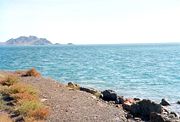
Over 80% of the country is covered by the Karakum Desert. The centre of the country is dominated by the Turan Depression and the Karakum Desert. The Kopet Dag Range, along the southwestern border, reaches 2,912 meters (9,553 ft). The Turkmen Balkan Mountains in the far west and the Kugitang Range in the far east are the only other significant elevations. Rivers include the Amu Darya, the Murghab, and the Tejen.
The climate mostly consists of an arid subtropical desert, with little rainfall. Winters are mild and dry, with most precipitation falling between January and May. The area of the country with the heaviest precipitation is the Kopet Dag range.
The Turkmen shore along the Caspian Sea is 1768 km long. The Caspian Sea is entirely landlocked, with no access to the ocean.
The major cities include Ashgabat, Türkmenbaşy (formerly Krasnovodsk) and Daşoguz.
Economy
Half of the country's irrigated land is planted with cotton, making the country the world's tenth-largest producer of it. It possesses the world's fifth-largest reserves of natural gas and substantial oil resources. In 1994, the Russian government's refusal to export Turkmen gas to hard currency markets and mounting debts of its major customers in the former Soviet Union for gas deliveries contributed to a sharp fall in industrial production and caused the budget to shift from a surplus to a slight deficit.
Turkmenistan has taken a cautious approach to economic reform, hoping to use gas and cotton sales to sustain its economy. In 2004, the unemployment rate was estimated to be 60%; the percentage of the population living below the poverty line was thought to be 58% a year earlier. Privatization goals remain limited. Between 1998 and 2002, Turkmenistan suffered from the continued lack of adequate export routes for natural gas and from obligations on extensive short-term external debt. At the same time, however, the value of total exports has risen sharply because of increases in international oil and gas prices. Economic prospects in the near future are discouraging because of widespread internal poverty and the burden of foreign debt.
President Niyazov spent much of the country's revenue on extensively renovating cities, Ashgabat in particular. Corruption watchdogs voiced particular concern over the management of Turkmenistan's currency reserves, most of which are held in off-budget funds such as the Foreign Exchange Reserve Fund in the Deutsche Bank in Frankfurt, according to a report released in April 2006 by London-based non-governmental organization Global Witness. According to the decree of the Peoples' Council of 14 August 2003, electricity, natural gas, water and salt will be subsidized for citizens up to 2030; however, shortages are frequent. On September 5, 2006, after Turkmenistan threatened to cut off supplies, Russia agreed to raise the price it pays for Turkmen natural gas from $65 to $100 per 1,000 cubic meters. Two-thirds of Turkmen gas goes through the Russian state-owned Gazprom.
Demographics
The majority of Turkmenistan's citizens are ethnic Turkmens who predominately adhere to Islam with sizeable minorities of Uzbeks, Persians and Russians. Smaller minorities include Kazakhs, Azeris, Balochis, Armenians, Koreans, and Tatars. A small number of Bukharian Jews used to live in Turkmenistan but almost none are left now. Turkmen is the official language of Turkmenistan, though Russian still is widely spoken in cities as a "language of inter-ethnic communication" (per the 1992 Constitution).



